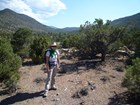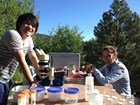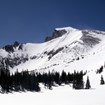The Midden is the Resource Management Newsletter of Great Basin National Park, published each summer and winter. Find out the latest going on at Great Basin National Park, Nevada in resource management and research. The Midden - Great Basin National Park: Vol. 15, No. 2, Winter 2015.
-
Great Basin National Park
Article 1: Tagging Bats in Great Basin National Park

Bats are incredibly valuable to humans in terms of ecosystem services. As suppressors of agricultural pests they provide an estimated $40 to $53 billion worth of pest control services per year in the US alone. Yet bats are threatened by a variety of anthropogenic factors. The most pressing issue facing bats in North American is disease. White-nose Syndrome has killed millions of bats in the northeastern US in the last decade. Read more
-
Great Basin National Park
Article 2: Figuring out How the Southern Snake Range Formed

New geologic research shows that the mountains of Great Basin National Park took millions of years to form. The southern Snake Range, the mountain range at the core of the park, was formed over the past 50 million years due to periods of intense stretching or extension of the Earth’s crust. The extension of the crust created many faults, or breaks along which rocks move up and down within the Earth. Read more
-
Great Basin National Park
Article 3: Searching for Beetles in Great Basin National Park
Carabidae is family of beetles that have a cosmopolitan distribution and are often very common in the United States. Surprisingly, the number of published records of carabid species from Nevada is staggeringly low. In fact, of all the US states, Nevada, with only 242 species, has the second smallest list of recorded species (Bousquet 2013). It seems clear that there is a deficiency in our knowledge of Nevada carabids. Read more
-
Great Basin National Park
Article 4: Stories of Early Lehman Cave Visitors
Nearly 2200 signatures and initials in Lehman Cave have been photographed and recorded to date. Many of the signatures are duplicates, marking repeated visits by the individual(s) or various locations visited during the same trip. For instance, William R. Bassett’s name or initials have been recorded 14 times. His first visit to the cave appears to be on September 12, 1885, within five months of the exploration of the cave. Read more
-
Great Basin National Park
Article 5: Overview of Resource Management’s SNPLMA Projects

The White Pine County Conservation, Recreation and Development Act of 2006 allowed the Resource Management (RM) Division at Great Basin National Park (GRBA) to compete for Southern Nevada Public Lands Management Act (SNPLMA) funds made available from the sales of public lands located in the Las Vegas Valley. Read more
-
Great Basin National Park
Article 6: National Environmental Policy Act (NEPA)
Mention your work involves the National Environmental Policy Act (NEPA) and likely the first response from the other person is “yuck” or “I feel sorry for you.” But it really is not that bad. Many people do not understand what the acronym NEPA refers to or just assume because your work involves NEPA your job is to create a barrier to their project’s success. However, that is far from being true. Read more



